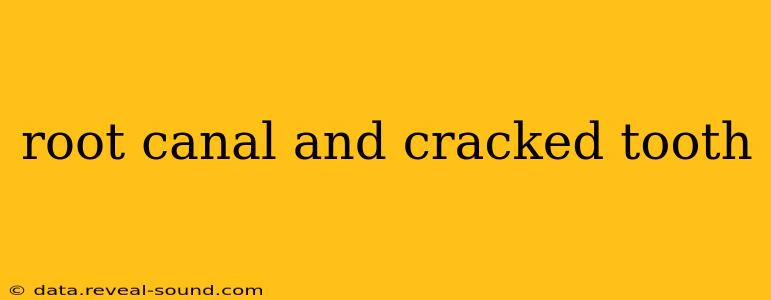A cracked tooth and the need for a root canal are often intertwined, representing a common dental challenge. Understanding the relationship between these two issues is crucial for effective treatment and preventing further complications. This comprehensive guide explores the connection between cracked teeth and root canals, explaining the causes, symptoms, diagnosis, and treatment options.
What is a Cracked Tooth?
A cracked tooth, also known as a fractured tooth, refers to any type of break or fracture in the tooth enamel. These cracks can range from tiny hairline fractures invisible to the naked eye to significant breaks extending into the tooth's dentin and even the pulp (the innermost part of the tooth containing nerves and blood vessels). The severity of the crack determines the necessary treatment.
Types of Cracked Teeth:
- Craze lines: These are tiny, superficial cracks in the enamel that don't cause pain and generally don't require treatment.
- Fractured cusp: A break in the chewing surface of a tooth.
- Cracked tooth: A crack that extends from the chewing surface down the side of the tooth.
- Split tooth: A crack that extends completely through the tooth.
- Vertical root fracture: A crack that extends from the root of the tooth upwards, often difficult to detect.
What is a Root Canal?
A root canal is a procedure performed to treat an infected or inflamed tooth pulp. The pulp, located within the tooth's central chamber and root canals, contains nerves and blood vessels. When the pulp becomes infected, typically due to deep decay, a large filling, trauma, or a crack, it can cause severe pain, swelling, and potentially lead to an abscess (a pocket of pus). The root canal procedure involves removing the infected pulp, cleaning and shaping the canals, and filling them with a biocompatible material to seal them off and prevent reinfection.
Can a Cracked Tooth Cause a Root Canal?
Absolutely. A cracked tooth is a frequent cause of requiring a root canal. When a crack penetrates the tooth's enamel and dentin, reaching the pulp, bacteria can easily invade, causing infection and inflammation. This infection of the pulp necessitates a root canal to save the tooth. The deeper and more extensive the crack, the higher the likelihood of needing a root canal.
How are Cracked Teeth Diagnosed?
Diagnosing a cracked tooth can sometimes be challenging, especially with hairline fractures. Your dentist will conduct a thorough examination, including:
- Visual examination: Checking for visible cracks or discoloration.
- Bite test: Gently applying pressure to the tooth to pinpoint the location of pain.
- X-rays: Identifying cracks that are not visible to the naked eye, especially vertical root fractures.
- Transillumination: Shining a light through the tooth to detect internal cracks.
What are the Symptoms of a Cracked Tooth?
Symptoms can vary depending on the severity and location of the crack. Some individuals experience no symptoms at all, while others may have:
- Sharp, shooting pain when chewing or biting: This is a common indicator.
- Sensitivity to temperature (hot or cold): The pain may linger even after the stimulus is removed.
- Lingering pain: The pain may persist even when not chewing or biting.
- Swelling or tenderness around the tooth: This suggests infection.
- Discoloration of the tooth: The tooth may appear darker than usual.
Can a Cracked Tooth be Treated Without a Root Canal?
Yes, sometimes. If the crack is superficial and hasn't reached the pulp, treatment might involve a filling or a dental crown to protect the tooth and prevent further damage. However, if the crack reaches the pulp, a root canal is typically necessary to save the tooth.
What Happens If a Cracked Tooth is Left Untreated?
Ignoring a cracked tooth can lead to serious complications, including:
- Severe pain and infection: The infection can spread to the surrounding tissues, resulting in an abscess.
- Tooth loss: The tooth may become so severely damaged that it needs to be extracted.
- Spread of infection: In severe cases, the infection can spread to the jawbone or other areas, requiring more extensive treatment.
How is a Cracked Tooth Treated?
Treatment depends on the severity of the crack and whether the pulp is involved:
- Filling: For minor cracks that haven't reached the pulp.
- Crown: To protect a weakened tooth and prevent further fracture.
- Root canal: When the crack reaches the pulp, requiring treatment to remove the infected tissue.
- Extraction: In cases where the damage is too extensive to save the tooth.
This information is intended for general knowledge and does not constitute medical advice. Always consult a qualified dentist for diagnosis and treatment of any dental problem.
